|
Touching the Past: Staffordshire Figures 1780 to 1840
| By Myrna Schkolne
Posted January 2014
|
 |
|
Early Staffordshire pottery figures are a prism for peering at the past through the eyes of those who made them. Fashioned between 1780 and 1840, they afford intriguing three-dimensional glimpses of people and events that we could not otherwise see because photography had not yet been introduced. The figures are intrinsically delicate, but they exude a naive robustness and a colorful cheerfulness that charms.
Today, Staffordshire figures are a rewarding collecting area because they are decorative and engaging, and fine figures can be found at prices that suit most pockets. A lovely small figure can be acquired for no more than the price of a modest big-city hotel room, and some collectors build interesting and satisfying collections at this level. Others prefer figures that cost much more. Figures vary widely in rarity, availability, quality, condition and commercial appeal, so the price range is broad. For example, the group titled, “Tee Total,” would cost about $8,000 today, while the sweet pair of dandies could probably be bought for under $2,000.
|
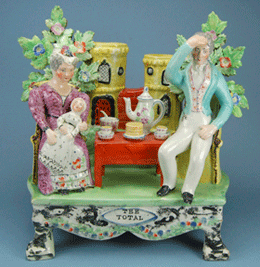
Teetotal group titled, “Tee total.” Attributed to the “Sherratt” potbank. Made in Staffordshire circa 1835; 8.1 inches.
|
The figures that we dub “Staffordshire” were, for the most part, made in the heart of Britain in the county of Staffordshire. From about 1780, Staffordshire’s pottery industry blossomed as improved modeling and painting techniques yielded attractive earthenware figures that were affordable alternatives to costlier porcelain figures. The figures were time-consuming to make because they required many molded parts and careful, all-over decoration. For design inspiration, the potters initially looked to classical imagery and existing porcelain figures, but as the market for pottery figures grew, they also turned their attention to their surroundings.
A multitude of early Staffordshire figures reveal the full spectrum of everyday life as it was then—street vendors, chimney sweeps, children at play, musicians and gardeners are all captured in clay. Others portray meaningful lifecycle events, including courtships, christenings and weddings. The figures in the photo of the two wedding groups remind us of how different marriage customs and laws were then. The bride and groom on the left stand before the blacksmith’s anvil in the village of Gretna Green, Scotland. This was the wedding destination of choice for couples who eloped to Scotland to evade the rigorous requirements of England’s marriage laws. The plaque reads, “John MacDonald aged 79 a Scotch esquire run of with a English girl aged 17 to Gratnal Green the old blacksmith to be married.” The group to the right celebrates the passage in 1823 of the New Marriage Act, legislation making it difficult to annul a marriage that violated minor marriage laws. Here the plaque reads “The new Marriage Act. John Frill and Ann Boke aged 21. That is right says the parson Amen says the clark.” In other words, once the marriage ceremony was concluded, there was no going back.
|
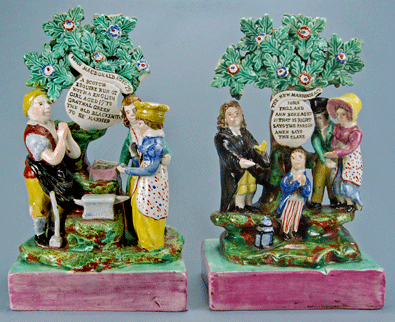
|
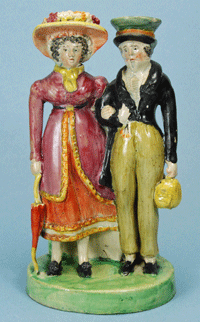
|
|
Gretna Green marriage group (l.) and the New Marriage Act group (r.). Made in Staffordshire circa 1825; 7.4 inches high. Figures in all photos are lead-glazed earthenware with enamel decoration.
|
Dandy and dandizette. Made in Staffordshire, circa 1820; 6.8 inches high.
|
Early Staffordshire figures are, of course, dressed in the garb of their day. Notice that neither bride in the weddings photo wears a white dress. White dresses were not yet mandatory bridal attire, so a bride simply wore her best dress.
Dandies—the name given to spiffily attired couples of that time—afford particularly amusing glimpses of bygone fashions, and these affected twosomes remind us of how ridiculous fashion can be if taken to the extreme. The dandy gentleman in the photo has a tightly cinched waist, courtesy of his corset. He carries a “man bag,” known as a reticule, to hold his necessary objects because pockets should not disturb the fit of his fashionably tight trousers. Not to be outdone, his dandizette reveals her ankles for the first time in western fashion history.
Of course, headline-grabbing murderers and their victims are portrayed in figural form, as are influential people from all walks of life—radical activists, religious leaders, politicians, military heroes, royalty, and actors and actresses, to name a few. Included are personae of American significance, such as Benjamin Franklin and Thomas Dartmouth Rice, the young white American actor, who created the role of Jim Crow.
|
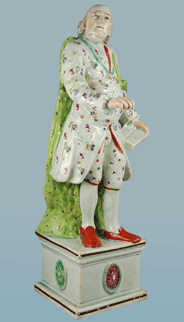
|
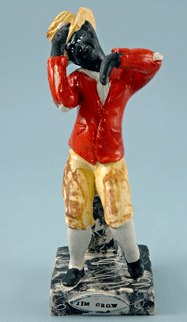
|
|
Benjamin Franklin. Attributed to Ralph Wood. Made in Staffordshire, circa 1785. H: 13 inches. (Photo: courtesy the William Herbert and Nancy Hunt Collection.)
|
Thomas Dartmouth Rice in the role of Jim Crow titled, “Jim Crow.” Attributed to the “Sherratt” pot bank. Made in Staffordshire, circa 1836. H: 6.8 inches. (Photo: courtesy of Andrew Dando Antiques.)
|
Other figures document events that influenced the course of western civilization including the Agricultural Revolution, the French Revolution, and the drive to abolish slavery. Very much at the forefront in that day was the drive to spread literacy. A host of figures show people reading, such as with the “Reading Maid” figure, for this today commonplace activity was then being newly introduced to the masses.
|
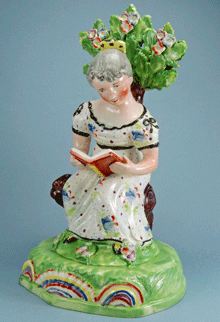
|
Reading maid. Attributed to the “Sherratt” potbank. Made in Staffordshire, circa 1820; 10.6 inches.
|
Another national movement also afoot in this period was the campaign to reduce drunkenness. From the 1830s, England’s teetotal movement proposed tea as a wholesome alternative to alcohol, and tea is being served in the group titled, “Tee Total,” while the gentleman clutches his head—a hangover perhaps?
Expectedly, early Staffordshire figures depict the sundry sports of their day. Barbaric sporting groups show animal baiting that the population then relished, while other figures portray the dancing bear and dancing dog routines that have since vanished into the mists of time. Genteel lady archers and gentlemen with their guns abound, but those were not the days of sports stars as we know them now.
|
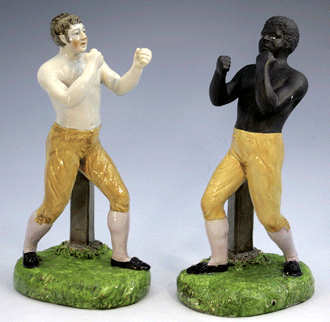
|
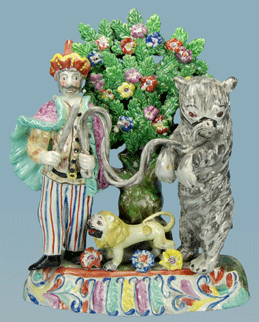
|
|
The English pugilist Thomas Cribb (l.) and his American challenger Thomas Molineaux (r.). Made in Staffordshire circa 1810; Height: 9 inches (l.); 8.7 inches (r). (Photo: courtesy John Howard; www.antiquepottery.co.uk.)
|
Dancing bear with Savoyard and a small lion. Made in Staffordshire, circa 1820. The lion is a dog dressed in a costume with a raffia wig.
|
Prior to 1780, England’s horses and dogs were its sporting stars, but in the 1780s, the first human sports stars rose to fame, and they were pugilists. The first international boxing matches took place in 1810 and 1811 between a white English champion, Thomas Cribb, and a freed Virginia slave, Thomas Molineux. Their two fierce slugfests have gone down in the annals of sporting history, and of course, Molineux and Cribb were crafted in figural form.
Early Staffordshire figures help us understand what mattered to people in that day—the classical figures that influenced the décor of the time and the host of biblical figures that reflect the centrality of faith. They compel us to ponder how far we have—or have not—come from that not-so-distant time of child chimney sweeps and vicious animal sports. Collectively, the figures document the people and events that shaped their era, and ultimately, the world we live in today.
Inevitably, life in England changed after 1840, and many of the people and activities recorded in earlier Staffordshire figures faded into the past. In 1839, the word photography entered our lexicon, and photographs, rather than figures, increasingly became the repositories of history. With the Industrial Revolution in full swing, simplification and mass-production were the order of the day, and simpler, cheaper, minimally decorated pottery figures became the norm. But early Staffordshire figures endure as colorful time capsules, storing within their clay bodies their tales of a bygone time. To hold one is to touch the past.
---------------------------------
Myrna Schkolne is the author of the recently published Staffordshire Figures 1780–1840, Vols. 1-4. These and her other books on early Staffordshire figures are available at most book sellers. She maintains a dialogue with the public on her website, www.mystaffordshirefigures.com.
|